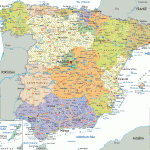Kate Atkinson makes the following comment in a Reader Guide included in the paperback edition of Life After Life: “To research the background of this book, I read as much as possible before beginning and then tried to forget as much as possible and simply write.”
Someday I may write well enough to do that, but right now I’m trying to figure out the Spanish Civil War and it’s making my head hurt. I’m making charts and little study aids, trying to remember that not all Republicans supported the Popular Front government; that the communists were actually the conservatives of the left, and communists come in different flavors, as do monarchists; that the Generals staging a coup liked to refer to the loyalists as “rebels and mutineers;” that the Basques were traditionally conservative and religious but repelled the generals in seeking self-rule; and the Catalans also wanted divorce from Madrid but couldn’t afford to antagonize the anarchists who didn’t want any government at all. But tallying up all the factions is like trying to count stars in the sky and even if you decide on a number, keeping them straight, and figuring out what side they were on is anything but straightforward.
To reduce this war to right vs. left doesn’t really tell the story. It must also be seen as a class struggle, as Catholic-based authoritarian rule vs. libertarian freedom, and of centralized government against regional autonomy. In Spain before the war church and state were one, two pillars of an authoritarian government that suppressed the people with brutality by the state, and a promise of a place in heaven.
On the Republican (Loyalist) side
- The Popular Front Government of the Republic sought a democratic government dominated by the moderate middle class.
- Basques and Catalans sought freedom from the state through autonomous self-rule.
- Anarchists sought to replace the government with local committees of unionists that would govern without leaders.
- Socialists sought a democratic, socialist central government dominated by the trade unions and an alliance with the anarchists.
- Soviet communists believed strongly in centralized control.
- Anti-Stalinist communists did not.
On the Nationalist (fascist) side:
- Carlists wanted to restore the monarchy of the Borbon Don Carlos line.
- Traditional monarchists favored the successors of Queen Isabella II
- Falange wanted a dictatorship of the privileged
- JONS was the socialist wing of the Falange
- CEDA was a political alliance of right-wing Catholic parties wanting to re-unite church and state with the power in the church.
- The Radical Republican Party wanted a religious quasi-democracy.
- The Liberal Republican Party just wanted to do away with the monarchy.
- Catalan League were bourgeois industrialists of Barcelona opposed to taxation from Madrid.
- The Generals wanted power. They saw the government as weak and ineffective, wanted to protect Spain from communist rule, despised the anarchists for everything they believed, had no use for the monarchy and wanted to use the Falange as a particularly brutal military force.
In 1936, the Popular Front government of the Second Republic of Spain had an anarchist inspired revolution on one side, and a military, Catholic, monarchist coup on the other. Its leaders didn’t know which way to turn.
“The ultimate paradox of the liberal Republic represented by its government was that it did not dare defend itself from its own army by giving weapons to the workers who had elected it.” Antony Beevor: The Battle for Spain


You are overthinking. I will match your Kate Atkinson quote with a Carson McCullers quote:
“A writer’s main asset is intuition; too many facts impede intuition.”